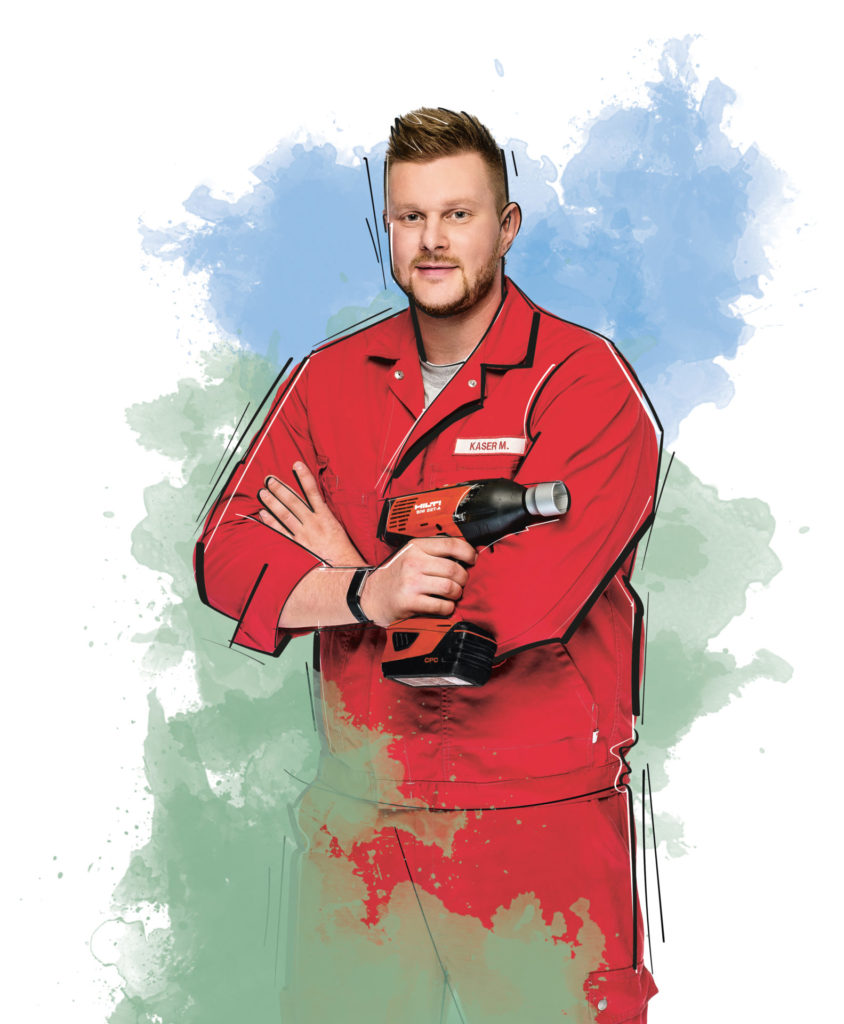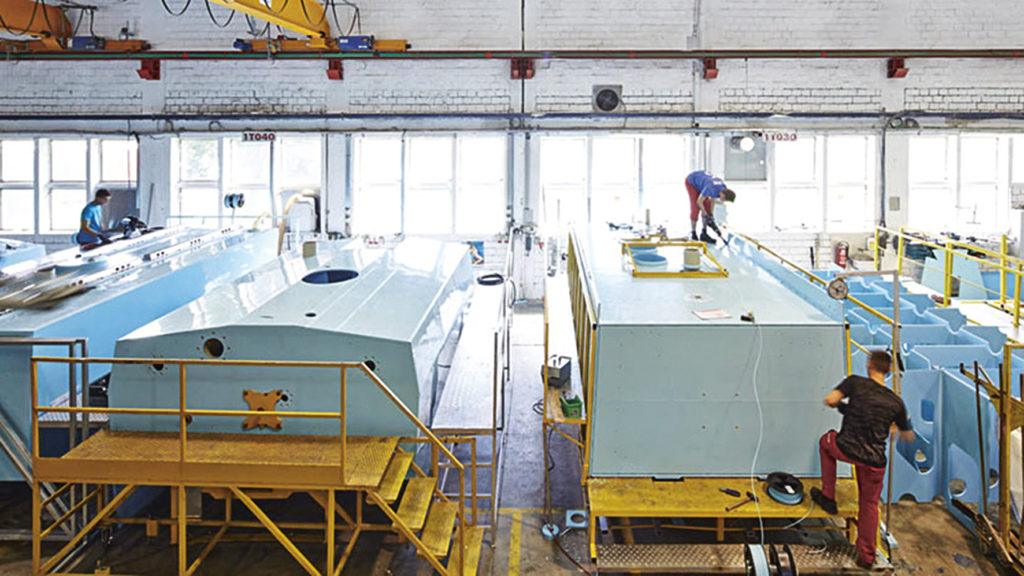▸ Environment & Resources
Environment & Resources
Rosenbauer takes responsibility for its products and the environment. That starts in Production. The company pays particular attention to using green electricity, reducing heat, fuel and water consumption, replacing energy-intensive equipment with energy-efficient alternatives, and preventing waste.
Rosenbauer’s production activities primarily involve machinery and specialty vehicle assembly, and/or metal and plastics processing. The environmental impact is therefore relatively low. Nevertheless, Rosenbauer takes responsibility for appropriate environmental protection and resource conservation measures in this area, too.
ENERGY CONSUMPTION AND CARBON EMISSIONS IN PRODUCTION
To continuously optimize its energy footprint, Rosenbauer analyzes and estimates all relevant workflows, machinery, buildings and processes according to their energy efficiency and develops corresponding measures to increase it. The following goals were set in 2018:
- Increase the share of green electricity used by the Group to 75% by 2021,
- generate 5% of total energy demand on Rosenbauer’s roofs by 2021, and thus
- reduce carbon emissions by 10% per productive hour by 2021.
In 2019, we first reviewed some of our electricity contracts in order to switch to electricity from renewable energy sources wherever possible. This enabled us to increase the share of green electricity to 65.6% (2018: 58.6%). The large production locations in Austria and Germany in particular have been operated using 100% green electricity since 2019.
The goal of covering 5% of total electricity needs with photovoltaic systems is expected to include both self-generated energy and electricity from systems on rooftops that are rented by Rosenbauer. Thanks to the photovoltaic systems installed in 2019 and ultimately commissioned in 2020 at the Leonding and Neidling locations with a total output of 620 kWp, a larger share of the electricity requirement will be covered in the coming years. Moreover, the roofs at other locations will be reviewed for suitability for additional photovoltaic systems in 2020.
These measures and our efforts to improve energy efficiency and save energy will help us meet our goal of reducing carbon emissions by 10% per productive hour by 2021 (2019: 4.6 kg per productive hour).
Status Goal Share of green electricity
Consumer
The highest demands on process and heating energy stem from production locations with paint shops. Sales, assembly and customer service operations account for most of our fuel consumption. Locations where the buildings and factory spaces require year-round cooling consume relatively high levels of electricity.
The Rosenbauer Group’s energy requirement in the reporting year totaled 67,485.1 MWh (19.3 kWh per productive hour) and therefore decreased slightly with regard to productivity.
Renewable sources supply 65.6% of the electrical energy, while 2.7% of that is from the in-house cogeneration plant in Leonding and a photovoltaic system in Mogendorf. The latter means that 0.5% of Rosenbauer’s electricity needs are met by power generated on the company’s roofs. Thanks to the newly installed system in Austria, this figure is expected to increase considerably next year. Rosenbauer sold 59.4 MWh of surplus electricity from the plant in Mogendorf. District heating, which is largely generated from waste heat, in turn provides 14.9% of the process and heating energy used. Diesel accounts for 91.8% of the fuel used.
The CO2 emissions from the Group’s energy consumption are correspondingly low at 15,951 t CO2eq.
| Energy consumption of Rosenbauer Group | 2019 | 2018 | 2017 |
|---|---|---|---|
| Total* | |||
| MWh | 67,485.1 | 63,024.1 | 63,208.4 |
| kWh per prod. hour | 19.3 | 19.5 | 21.6 |
Electricity |
|||
| MWh | 16,530.0 | 15,541.9 | 14,698.9 |
| kWh per prod. hour | 4.7 | 4.8 | 5.0 |
Heating |
|||
| MWh | 34,099.3 | 30,524.6 | 30,936.7 |
| kWh per prod. hour | 9.8 | 9.5 | 10.6 |
Fuels |
|||
| MWh | 16,855.9 | 16,957.6 | 17,572.8 |
| kWh per prod. hour | 4.8 | 5.2 | 6.0 |
| Greenhouse gas emissions of Rosenbauer Group (in t CO2eq)* | Market-based | Country-based | ||||
|---|---|---|---|---|---|---|
| 2019 | 2018 | 2017 | 2019 | 2018 | 2017 | |
| Total Scope 1 + Scope 2 | 15,951 | 14,782 | 14,817 | 19,017 | 17,717 | 17,546 |
| Direct greenhouse gas emissions (Scope 1) | 10,260 | 9,430 | 9,535 | 10,260 | 9,430 | 9,535 |
| Indirect energy-related emissions (Scope 2 resulting from the use of district heating and electricity) | 5,691 | 5,352 | 5,282 | 8,758 | 8,287 | 8,011 |
All renovations and conversions include thermal insulation for buildings and factory spaces, and offices are equipped with modern daylight and heating controls. LED lighting is gradually being introduced in factory spaces, and energy-saving tools such as speed-controlled air compressors with consumption control are used as well. When the Radgona, Slovenia, location was retrofitted, heat exchangers were installed to blow warm air near factory ceilings back downward, thereby considerably reducing the need for heating.
In Production, the majority of our European firefighting vehicles are already built on chassis with a Euro 6 drivetrain, which means their NOx and particulate emissions are respectively 80% and 66% lower than those of Euro 5 vehicles.

choose
“Choosing materials is easy. But we take it personally.”
MATTHIAS KASER
OPERATIONS PANTHER

SUSTAINABLE TANK PRODUCTION
Rosenbauer vehicles’ water tanks are made of a sustainable material that can be recycled repeatedly.
In mid-2019, a carpooling app called Carployee was introduced for employees in the locations in Upper Austria. By arranging carpools to and from work, employees can save money and time and, at the same time, lessen their impact on the environment. Rosenbauer offers special benefits to active users. In 2019’s five-month test phase alone, employees traveled 34,000 km less, which is the equivalent of saving 4 t of CO2. With the official launch of Carployee at the beginning of 2020, use of the app increased manifold. As early as January, employees emitted nearly 10 t less CO2 during commutes. In addition to protecting the environment, the app contributes to promoting communication, even across departments, which also leads to a constant exchange of ideas. The interplay between transportation, HR and environmental awareness creates measurable benefits for all participants and contributes significantly to the efficient use of resources.
RESOURCE CONSUMPTION AND WASTE IN PRODUCTION
Water
Rosenbauer supplies a wide range of extinguishing systems as well as high and ultra-high pressure pumps for efficient extinguishing with less water. As some water is required to produce firefighting pumps, specifically in the course of various quality tests, one of Rosenbauer’s chief concerns is to ensure the careful use of this resource.
Leonding plant I has the highest water requirement of any location in the Group. This is where Rosenbauer produces all pumps and extinguishing systems that must be repeatedly tested with water as part of quality assurance. Water is also required for vehicle deliveries to demonstrate the extinguishing functions for customers. This is the case at most Rosenbauer production locations worldwide.
On the pump test stands, where every unit from the smallest portable pump to the highest-volume truck-mounted fire pump is subject to a one-hour endurance test, the required water is recirculated. Depending on the pump capacity, this saves between 30 and 780 m³ of fresh water in each test cycle. Since around 3,000 units are tested per year, this saves an enormous volume of water.
The water used by Rosenbauer contains only very minimal contaminants. At all locations, waste water is of sufficient quality and is therefore released into the public sewer system. In addition, water purification facilities, such as mineral oil separators, are installed at several locations. This keeps the environmental impact of waste water as low as possible.
Service water consumption at the Rosenbauer Group was 90,285.9 m³ in the reporting year, which is 25.8 liters per productive hour, resulting in a slight improvement with regard to productivity. Almost 52.5% of this came from our own wells and the remainder from municipal supplies.
| Water consumption of Rosenbauer Group (m3) | 2019 | 2018 | 2017 |
|---|---|---|---|
| Municipal | 42,944.9 | 37,989.7 | 41,639.7 |
| Liters per prod. hour | 12.3 | 11.8 | 14.3 |
| Wells | 47,341.0 | 39,848.0 | 30,882.0 |
| Liters per prod. hour | 13.5 | 12.3 | 10.6 |
| Total* | 90,285.9 | 77,837.7 | 72,521.7 |
| Liters per prod. hour | 25.8 | 24.1 | 24.9 |
Water consumption in 2018 was reduced retrospectively because the amounts charged to sub-tenants at one location were not deducted.
Water consumption of Rosenbauer products
Water is the most important and most widely used extinguishing agent worldwide and has excellent extinguishing properties. Rosenbauer’s smallest standard pressure pump, the N10, has a delivery rate of up to 1,800 l/min. Our most powerful unit, the new N130, delivers over 13,000 l/min at 10 bar.
With the NH series, Rosenbauer also offers truck-mounted fire pumps with an integrated high-pressure stage. These operate at four times the pressure (40 bar) of standard pressure pumps, finely atomizing the extinguishing water and greatly increasing the surface area of the water. This means it can penetrate deeply into the burning material, which in turn optimizes its extinguishing effect. The high-pressure pumps are efficient at fighting fires. They also minimize consequential damage caused by firefighting operations, because there is less contaminated water that can damage the fabric of the building. In 2019, 33% of all the pumps Rosenbauer produced were supplied with a high or ultra-high pressure option.
| Waste of Rosenbauer Group | 2019 | 2018 | 2017 |
|---|---|---|---|
| Total* | |||
| t | 3,450,0 | 3,668.1 | 5,199.2 |
| kg per prod. hour | 1.0 | 1,1 | 1.8 |
| t | 178.3 | 160.2 | 193.1 |
| kg per prod. hour | 0.05 | 0.05 | 0.1 |
| Recyclable waste* | |||
| t | 2,966,9 | 3,197.8 | 4,614.3 |
| kg per prod. hour | 0.9 | 1.0 | 1.6 |
| Residual waste | |||
| t | 304.8 | 310.0 | 391.8 |
| kg per prod. hour | 0.1 | 0.1 | 0.1 |
* Used material, non-hazardous waste without residual waste
Waste
The volume of waste produced by the Rosenbauer Group in 2019 was 3,450 t (1 kg per productive hour). Of this amount, 5.2% of waste was hazardous, such as paints, solvents, batteries and used oil. Residual waste for disposal accounted for 8.8% of the total. All other used materials and waste were recycled. Specifically, this included aluminum, steel, recyclable plastics and cable residues, wood, glass, cardboard and paper. The figures are partly based on estimates, as not all locations keep detailed records. For waste disposal, Rosenbauer recycles as a matter of course and relies on local conditions and suppliers at all locations.
The highest volume of waste, at 768.6 t, was generated at Leonding plant I, which is also the site of the Group’s largest logistics center. Waste at this location was significantly reduced in 2019. Waste collection islands are distributed over the entire site at every location and arranged so as to accurately separate the waste and residual materials accumulating in each area. Final disposal is carried out by authorized specialists. The maxim for all employees is “prevention rather than separation, separation rather than recycling, and recycling rather than disposal”. A specific measure implemented at the service location in France and a production location in Germany, for example, was replacing disposable cloths for cleaning oil residue with reusable cloths washed by a cleaning service.